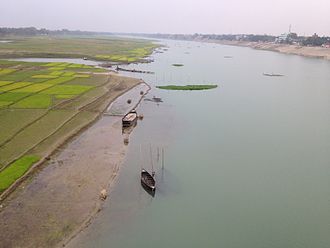Mahananda River

The Mahananda River (Pron:/ˌməhɑːˈnʌndə or ˌmɑːhəˈnʌndə/) is a trans-boundary river that flows through the Indian states of Bihar and West Bengal, and Bangladesh. It is an important tributary of river Ganga.
The Mahananda originates in the Himalayas: Paglajhora Falls on Mahaldiram Hill near Chimli, east of Kurseong in Darjeeling district at an elevation of 2,100 metres (6,900 ft).[1][2][3] It flows through Mahananda Wildlife Sanctuary and descends to the plains near Siliguri. It touches Jalpaiguri district.[2][4]
It enters Bangladesh near Tentulia in Panchagarh District, flows for 3 kilometres (1.9 mi) after Tentulia and returns to India.[5] After flowing through Uttar Dinajpur district in West Bengal and Kishanganj, Purnia and Katihar districts in Bihar, it enters Malda district in West Bengal.[6][7] The Mahananda divides the district into two regions — the eastern region, consisting mainly of old alluvial and relatively infertile soil is commonly known as Barind (Borendrovomee), and the western region, which is further subdivided by the river Kalindri into two areas, the northern area is known as “Tal”. It is low-lying and vulnerable to inundation during rainy season; the southern area consists of very fertile land and is thickly populated, being commonly known as “Diara”.[8]
It joins the Ganges at Godagiri in Nawabganj district in Bangladesh.
The total length of the Mahananda is 360 kilometres (220 mi),[9] out of which 324 kilometres (201 mi) are in India and 36 kilometres (22 mi) are in Bangladesh.
The total drainage area of the Mahananda is 20,600 square kilometres (8,000 sq mi) out of which 11,530 square kilometres (4,450 sq mi) are in India.
